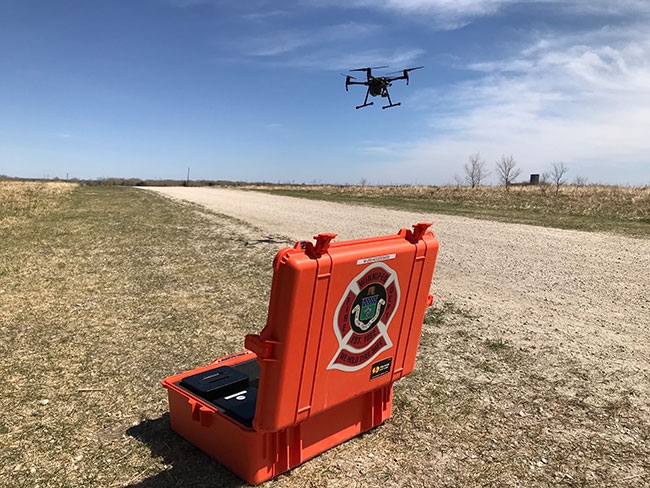
Features
Leadership
UAVs in the fire service
In 2018, the Winnipeg Fire Paramedic Service launched an innovative Unmanned Aerial Vehicle (UAV) program. To our knowledge, this is the first full-time, in-service UAV program in the Canadian fire service available to respond immediately 24 hours a day, 365 days a year.
April 11, 2019
By Scott Wilkinson
 The DJI Matrice 200 on a test flight. In 2018
The DJI Matrice 200 on a test flight. In 2018The reception has been overwhelmingly positive and the program has already demonstrated its value on many occasions.
It all started in 2016 with funding from the City of Winnipeg Innovation Capital Fund which supports innovation and provided the initial funding money for program development. This support from the city and, more importantly, the support from Fire Paramedic Chief John Lane, allowed us to begin establishing this vital technology in our service.
We began by identifying our equipment needs and overall direction with a committed group from within the department. Next came the acquisition process for equipment and training support via our finance division, which led to our work with Indro Robotics out of British Columbia.
Early and ongoing collaboration with such an industry partner was another important part of our successful development.
Our group then worked with Indro to confirm our equipment and training plans and work on the development of our supporting documentation and application for our Transport Canada special flight operations certificate.
The appropriate training was the next essential step forward. Although individual public citizens could fly with fairly basic instruction, we wanted to ensure a much more advanced level of expertise with our staff.
Two instructors were developed with Indro using Transport Canada-approved training. They then delivered the training to our operational pilots.
Two full weeks of training was conducted, including one week of ground school and trainer drone practical followed by a period of mentored practice, and a second week of advanced training with our operational drone, including complicated scenarios, night flight and more.
We now have 18 trained pilots across our four shifts as well as a cadre of trained visual observers to assist the pilots. This ensures our minimum manning staffing of one pilot and one visual observer on our rescue apparatus that responds with the UAV.
Recent regulatory changes by Transport Canada have created a more stringent pilot certification process, but due to the training we already have in place, this does not create any significant issues for our service.
The selection of the most suitable aircraft was much more than a trip to the local big box electronics store on sale day. This is another area that demands thorough research before any purchasing is done.
Budget, local weather and expected function are all important components of this process and not all drones are created equal. Our service settled on a DJI Matrice 200.
The final pieces in the puzzle were the completion of a flight operations certificate, followed by our flight permissions process with NAV Canada for our flights in controlled airspace.
This was completed in July 2018 and provided the regulatory green light for our program.
While everything else was going on, we completed development of our departmental standard operating procedure for the program and had to establish the necessary determinants for dispatch in our computer-aided design system with the help of our communications branch. This was finalized in August and our program went live at that time.
The team can be dispatched to confirmed wildland, hazmat, water rescue, technical rescue and second-alarm working fires and can be requested by the incident commander to attend any other incident as required. To date, UAVs have been used at more than 30 of these incidents.
Two missions of note were a major asphalt-plant fire adjoining our city and a large industrial seed-plant fire. They occurred just two weeks apart in late October/early November. The UAV was a game-changer at both incidents. It provided visual reconnaissance that otherwise would have been unattainable.
Due to the nature of the incident at the asphalt-plant fire, incident command and staging were more than 800 metres away with no direct view of the site. The drone was able to provide commanders with real time 4K video of the incident to guide risk assessments, planning, tactical deployment and stream placement.
Even the most hesitant of our members have now been able to see the benefits of the UAV and many of our incident commanders are wondering how they managed without it at these more complex incidents.
If your service was ever thinking of initiating its own UAV program, don’t hesitate any longer. The investment is manageable and the dividends well worth it.
Just be sure to take the time to do it properly with the right research, planning and support.
Scott Wilkinson is senior academy officer in the training academy at the Winnipeg Fire Paramedic Service.
Print this page